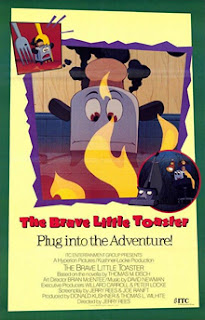Director: Jerry Rees Studio: Walt Disney Pictures Genre(s): Drama/Musical Rated: G |
When John Lasseter first pitched “The Brave Little Toaster”
to Disney executives as a potential movie for him to direct, he was surprised
to find his vision for a 2D animated movie with computer animated backgrounds
was not met with much enthusiasm from the executives running the studio at the
time. They felt that there was no reason
to make a movie with computers if it didn’t result in the final product being
made either faster or cheaper (ideally both).
Lasseter was dismissed from the company that very day and he moved on to
Pixar, where he would end up making another movie where toys secretly pined to
be played with by humans (I’m assuming you all know what I’m talking about). Despite his dismissal from the project,
Disney did end up financing “The Brave Little Toaster” and future Pixar alumni
Joe Ranft even worked on the screenplay.
Considering what Pixar would eventually make, it’s difficult
not to look at “The Brave Little Toaster” without some disappointment, but it
is still a worthwhile movie in its own right.
It manages to have the feeling of a Pixar movie with the musical numbers
Disney was known for making so well at the time. It is funny to think that a toaster, lamp,
radio, and even the vacuum cleaner would all miss the kid who used to frequent
the cabin so much (the blanket makes more sense), but I suppose it was a strange
enough idea anyway. After several years of
the Master (as he is so affectionately called) not showing up, the appliances
decide it is time to go out into the world and find him themselves. The following journey has highs, lows, and
even a decent song or two thrown in for good measure. Some future “Saturday Night Live” regulars
even pop in to lend their vocal talents to bring the inanimate objects to life
(like Jon Lovitz and the late Phil Hartman).
Everyone is likely to have a favorite character in all of
this. The title toaster himself does
leave an impression with his optimism and good spirits, but my personal
favorite is Kirby, the grumpy old vacuum cleaner who secretly has a heart of
gold. Animation fans may recognize the
voice of Thurl Ravenscroft, who in his life would achieve animation immortality
by voicing Tony the Tiger and singing a song about some mean green guy being a Grinch
around Christmas. Now, I mentioned the
history of the film at the beginning of this review because it puts into
context why the movie is still good despite the fact that Pixar would eventually
go on to revolutionize the story with “Toy Story.” “The Brave Little Toaster” was still a
product of love. It was made on a
shoestring budget. It had the perplexing
task of getting audiences to care about household appliances on an emotional
level.
Disney might not have pushed very hard for this to be seen
in theaters, but when it was shown at film festivals it was met with lots of acclaim. People couldn’t believe that the plight of a
toaster could be taken seriously on any level, much less the sadness that is
sometimes on display here. At one film festival,
the movie was even nominated for ‘Best Film in Drama,’ but the judges admitted to
not giving it the award for fear that they wouldn’t be taken seriously anymore. I think that speaks more about the bad
reputation animation has than anything else (a few years later some of those
same festivals would happily embrace “Beauty & the Beast” as an instant
classic). “The Brave Little Toaster” is
not a perfect film and it might not have achieved classic status, but it is still
a fine movie with great emotion and some revolutionary ideas on what audiences
would get emotionally attached to.
Some may watch the movie now and think that Pixar has been
able to do this idea a lot better. And
yes, they would be correct in this assessment.
The thing about clever ideas though is that it is just as valuable to
understand where they originated from and where they have come since. A friend of mine once called this a “blueprint
film,” meaning it was a new idea at the time that deserves to be lost because
better things have come. It may have
been first but there’s a reason ballet dancers practice the basics even when
they are pros: Because you don’t want to forget what worked initially. Considering the movie has long been out of
print and does not appear to be available digitally, I fear people may lose
sight of this one someday (and I don’t think anyone at Disney cares enough to
fix that problem). I wonder what
Lasseter thinks about that scenario?
|
|
|
|
| CONSUMER ADVICE |
Parents, despite the G rating, there are some dark and disturbing scenes of death. Recommended for ages 6 and up.
|







